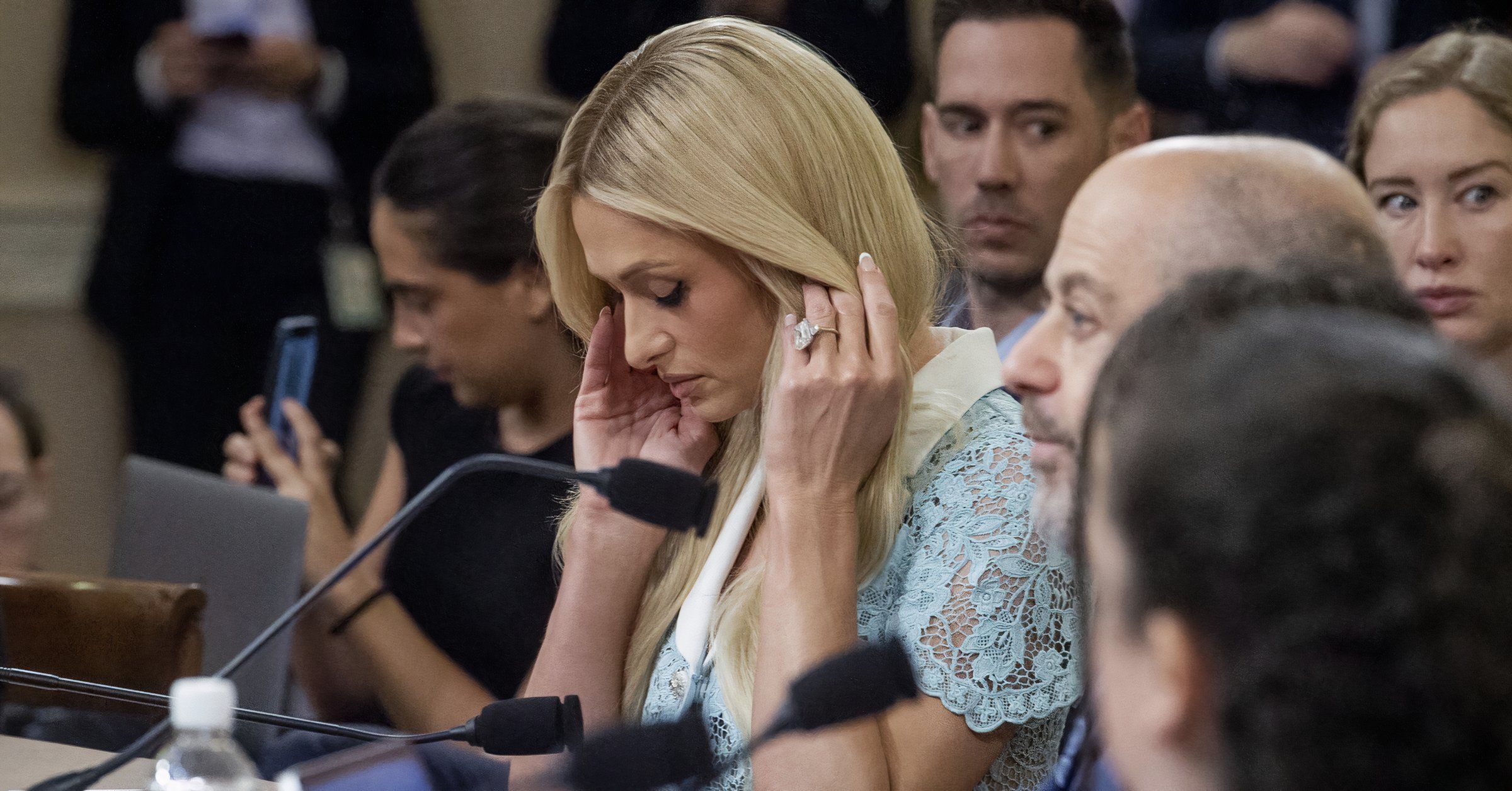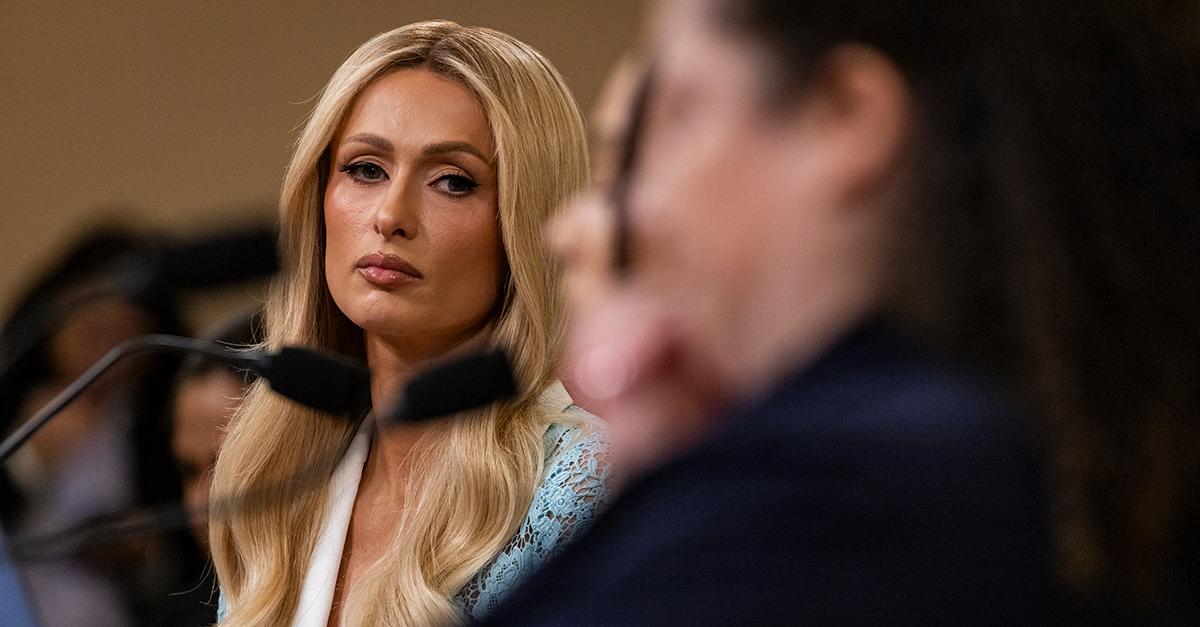Breaking Down: Why Did Paris Hilton's Voice Change? The Facts!
Ever wondered why Paris Hilton's voice sounds different now than it did in the early 2000s? The transformation is striking, and it's not just your imagination; the iconic heiress's vocal timbre has indeed shifted, raising questions about the underlying causes.
Paris Hilton, the name synonymous with early 2000s celebrity culture, has remained a fixture in the public consciousness for over two decades. From reality television to business ventures, her presence has been enduring. However, one subtle yet noticeable aspect of her public persona has evolved: her voice. Gone is the high-pitched, almost childlike breathiness that characterized her early appearances. In its place is a lower, sometimes raspier tone, prompting speculation and curiosity about what factors might be at play. The shift is undeniable, marking a departure from the vocal signature that once defined her.
The inquiry into Paris Hilton's vocal transformation reveals a complex interplay of potential causes. While definitive answers remain elusive, several contributing factors emerge as the most plausible. The natural aging process, with its inevitable effects on the vocal cords, stands as a primary suspect. Simultaneously, lifestyle choices, most notably smoking, may have exerted a significant influence. The convergence of these elements offers a compelling explanation for the audible changes observed in Hilton's voice over the years.
- Meet The Champions Sheila Ysrael Dan Fernandezs Dance Journey
- Unveiling The Arctic Cold War Key Players Characters Explored
Regardless of the precise combination of influences, the evolution of Paris Hilton's voice serves as a potent reminder of the human condition. Even those who occupy the highest echelons of fame and fortune are not exempt from the passage of time and the cumulative impact of lifestyle choices. The subtle yet perceptible alteration in her vocal quality underscores the universality of these processes, bridging the gap between celebrity and the shared experiences of aging and personal habits.
| Name | Paris Whitney Hilton |
|---|---|
| Date of Birth | February 17, 1981 |
| Place of Birth | New York City, New York, U.S. |
| Occupation | Media personality, socialite, businesswoman, model, singer, actress, DJ |
| Net Worth | $300 million |
| Official Website | parishilton.com |
The journey of Paris Hilton's voice is more than just an auditory observation; it's a study in the effects of time, habits, and public life. The transformation from a breathy ingenue to a more seasoned, and arguably more authentic, vocal presence prompts a deeper look into the factors that contribute to these shifts.
The nuances of vocal change often lie within the delicate anatomy of the larynx. With age, the vocal folds, responsible for producing sound, undergo structural modifications. These changes, while subtle, can have a profound impact on vocal quality.
- Breaking Gabe Watson And Kim Lewis Are They Still Together Find Out
- Who Is Tim Scotts Daughter All About Jenn Scott Updated
As we mature, the vocal cords, composed of collagen and elastin fibers, begin to lose their elasticity. This is largely due to the decrease in production of these proteins, which are responsible for maintaining the vocal cords' suppleness and vibratory capacity. Consequently, the vocal cords may not vibrate as rapidly or efficiently as they once did, leading to a perceptible lowering of pitch.
Vocal aging, a gradual and multifaceted process, typically commences around the fourth decade of life. However, the timeline and trajectory of this evolution can vary significantly among individuals. Certain factors, such as smoking, excessive alcohol consumption, and vocally intensive professions, can accelerate the aging process, leading to premature or more pronounced vocal changes. Singers, teachers, and public speakers, for example, may experience earlier or more significant alterations in their vocal quality due to the demands placed on their vocal apparatus.
At 42, Paris Hilton likely finds herself navigating the initial stages of vocal aging. The subtle shifts in her vocal cords, a consequence of the aging process, may contribute to the observed lowering of her vocal pitch. These changes, while inevitable, are part of the natural evolution of the human voice, reflecting the cumulative impact of time on the delicate structures responsible for sound production.
Understanding the implications of vocal aging is crucial for both performers and everyday individuals. Recognizing the potential changes and adopting proactive strategies for vocal health can help preserve vocal quality and functionality as we age. Proper hydration, vocal warm-ups, and avoiding vocal strain are just a few measures that can mitigate the effects of time on the voice.
Beyond the natural aging process, lifestyle choices can exert a significant influence on vocal health. Smoking, in particular, stands out as a major risk factor for vocal cord damage. The noxious chemicals inhaled during smoking can wreak havoc on the delicate tissues of the larynx, leading to a range of vocal problems.
The detrimental effects of smoking on the vocal cords are multifaceted. The chemicals in cigarette smoke act as irritants, causing inflammation and swelling of the vocal cords. This inflammation can lead to hoarseness, raspiness, and a general decrease in vocal clarity. Over time, chronic inflammation can lead to more serious damage, including the formation of vocal cord polyps or nodules, which can further impair vocal function.
The long-term effects of smoking on the voice can be profound. Persistent inflammation and irritation can alter the structure of the vocal cords, making them less flexible and less capable of producing a clear, resonant sound. In severe cases, smoking can lead to irreversible vocal damage, necessitating medical intervention or even vocal rehabilitation therapy.
Given Paris Hilton's history as a smoker, it is highly plausible that smoking has contributed to the observed changes in her voice. The cumulative effects of years of smoking could have led to inflammation, irritation, and structural changes in her vocal cords, resulting in a lower, raspier vocal quality. While the precise extent of smoking's impact remains speculative, it is a significant factor to consider when analyzing her vocal evolution.
For smokers who value their vocal health, cessation is paramount. Quitting smoking can halt the progression of vocal damage and even allow for some degree of vocal recovery. Consulting with a healthcare professional about smoking cessation strategies is a crucial step in protecting and preserving vocal function.
Beyond the tangible factors of aging and smoking, the realm of vocal techniques offers another lens through which to examine Paris Hilton's vocal transformation. Vocal fry, a technique characterized by a creaky or gravelly vocal quality, has become increasingly prevalent in contemporary speech.
Vocal fry, also known as "glottal fry" or "creaky voice," involves vibrating the vocal cords at an exceptionally low frequency. This produces a distinct sound that has been variously described as raspy, creaky, or gravelly. While vocal fry has gained popularity among certain speakers, its impact on vocal health remains a subject of debate.
Some researchers suggest that excessive or improper use of vocal fry can strain the vocal cords, leading to vocal fatigue, hoarseness, and even vocal cord damage. Others argue that when used sparingly and with proper technique, vocal fry can add character and expressiveness to the voice without causing harm. The key lies in moderation and awareness of one's vocal limitations.
Paris Hilton has been observed employing vocal fry in her speech, particularly in recent years. This stylistic choice may contribute to the perception of a lower, raspier voice. Whether her use of vocal fry is intentional or subconscious remains unclear, but its presence adds another layer to the analysis of her vocal evolution.
Deciding whether to incorporate vocal fry into one's speech is a matter of personal preference. However, it is essential to be aware of the potential risks and benefits before adopting this technique. Practicing vocal fry under the guidance of a trained vocal coach can help minimize the risk of vocal strain and ensure proper technique.
The benefits of vocal fry, when used judiciously, include the ability to add emphasis to certain words or phrases, create a more edgy or dramatic effect, and project a sense of casualness or nonchalance. However, the risks include potential vocal cord strain, a perception of unprofessionalism, and difficulty being understood by listeners.
Ultimately, vocal fry is a tool that can be used to enhance vocal expression. However, it should be wielded with caution and awareness to avoid potential damage to the delicate vocal apparatus.
The subtle nuances of accent contribute significantly to our vocal identity. Over time, accents can evolve, influenced by a myriad of factors including geographic mobility, social interactions, and conscious efforts to modify speech patterns. Paris Hilton's accent, once characterized by the distinctive cadences of a "Valley Girl," has undergone a noticeable transformation over the years.
Hilton's early accent, emblematic of the Southern California social scene, was marked by uptalk, vocal fry, and a distinct set of pronunciations. This accent, often associated with youth and affluence, contributed to her public persona as a quintessential "it girl."
As Hilton's career expanded and her social circles broadened, her accent began to shift. Exposure to diverse cultures, frequent travel, and interactions with individuals from various linguistic backgrounds likely influenced her speech patterns. In addition, as Hilton transitioned from socialite to businesswoman, she may have consciously modified her accent to project a more professional and sophisticated image.
The evolving landscape of professional communication also plays a role. In many industries, a more neutral or standardized accent is perceived as advantageous, facilitating clear communication and minimizing potential biases. Hilton, as a prominent figure in the business world, may have adapted her accent to align with these expectations.
Hilton's accent transformation reflects her personal growth and evolution. The shift away from the pronounced "Valley Girl" accent signifies her transition from a youthful socialite to a more mature and multifaceted businesswoman.
The influence of different cultures on accent is undeniable. Immersion in new linguistic environments can lead to subtle shifts in pronunciation, intonation, and vocabulary. These changes, often subconscious, reflect the adaptability of the human voice and our tendency to mimic the speech patterns of those around us.
Paris Hilton's extensive travels and interactions with individuals from diverse cultural backgrounds have undoubtedly influenced her accent. Exposure to different languages and speech patterns may have subtly altered her pronunciation and intonation, contributing to the overall shift in her accent.
The desire to be perceived as professional and credible can also drive accent modification. In many professional settings, a neutral or standardized accent is viewed as more authoritative and less likely to be subject to bias or prejudice. Individuals seeking to advance their careers may consciously or subconsciously modify their accents to conform to these expectations.
Paris Hilton's transition from socialite to businesswoman may have motivated her to refine her accent. A more neutral accent could be perceived as more polished and professional, enhancing her credibility in the business world.
The complex interplay between health conditions and vocal quality is often overlooked. Certain illnesses can directly or indirectly affect the vocal cords and surrounding structures, leading to noticeable changes in the voice. In Paris Hilton's case, her diagnosis with Lyme disease in 2018 raises questions about its potential impact on her vocal health.
Lyme disease, a bacterial infection transmitted through tick bites, can manifest in a wide range of symptoms, including fatigue, muscle pain, joint inflammation, and neurological complications. While vocal changes are not a primary symptom of Lyme disease, the infection's impact on the nervous system could potentially affect vocal cord function.
Lyme disease can affect the nervous system, causing inflammation and damage to nerves throughout the body. If the nerves that control the vocal cords are affected, it could lead to vocal weakness, hoarseness, or changes in vocal pitch. However, it is important to note that neurological complications are not a common occurrence in Lyme disease, and vocal changes are even less frequent.
The inflammation associated with Lyme disease can also indirectly affect the vocal cords. Systemic inflammation can cause swelling and stiffness in the muscles and tissues surrounding the larynx, potentially impacting vocal cord movement and vibration. However, this is a less direct mechanism, and the extent of its impact on vocal quality would likely be subtle.
Given the potential for Lyme disease to affect the nervous system and cause inflammation, it is plausible that Hilton's diagnosis has contributed to the changes in her voice. However, it is difficult to definitively determine the extent of Lyme disease's impact, as other factors, such as smoking and aging, are also likely at play.
The world of public relations and media often involves strategic communication techniques. Media training, designed to enhance communication skills, can play a significant role in shaping a public figure's vocal delivery and overall presentation.
Media training encompasses a variety of techniques aimed at improving communication skills in media settings. It typically involves instruction on vocal projection, articulation, body language, and message delivery. The goal is to help public figures communicate effectively, confidently, and persuasively.
Media training can equip public figures with the tools to control their vocal tone, pace, and volume. This can help them project a more authoritative and engaging presence. By consciously manipulating these vocal elements, public figures can tailor their delivery to suit different audiences and contexts.
Media training often includes techniques for improving articulation and pronunciation. Clear and precise speech enhances comprehension and credibility. Public figures may work with vocal coaches to refine their pronunciation and eliminate any distracting speech patterns.
Paris Hilton, as a prominent public figure, has likely undergone media training at various points in her career. This training could have influenced her vocal delivery, contributing to the changes observed in her voice over time.
The conscious effort to project a certain image can also drive vocal modification. Public figures may consciously alter their vocal tone and delivery to align with their desired persona. This can involve lowering their vocal pitch, slowing their speech pace, or adopting a more authoritative tone.
Paris Hilton, in her transition from socialite to businesswoman, may have consciously modified her vocal delivery to project a more professional and credible image. This could have involved lowering her vocal pitch and adopting a more deliberate speaking style.
This section addresses frequently asked questions surrounding the noticeable changes in Paris Hilton's voice over the years.
Question 1: What are the primary factors contributing to Paris Hilton's voice change?
Paris Hilton's voice has undergone a transformation, primarily attributed to a combination of factors. The natural aging process has played a role, as her vocal cords have thinned and lost elasticity over time. Additionally, her smoking habit has contributed to the development of a lower and raspier vocal quality.
Question 2: How has Paris Hilton's accent evolved over the years?
Hilton's accent has also undergone a noticeable shift. In her early days, she was known for her pronounced "Valley Girl" accent. However, as she has matured and gained exposure to diverse cultures, her accent has become more neutral, reflecting her global experiences and desire to be taken seriously as a businesswoman.
In reality, the evolution of Paris Hilton's voice is a symphony of influences, orchestrated by the passage of time, lifestyle choices, and the demands of a life lived in the public eye. From the subtle shifts in vocal cord elasticity to the conscious refinement of her accent, each factor has played a role in shaping the vocal signature we hear today.
The intricate process of vocal aging, as collagen and elastin production naturally declines, resulting in a gradual lowering of pitch and a shift in vocal quality. This inevitable transformation is a testament to the body's natural processes, a gentle reminder of the passage of time.
The harsh reality of smoking's impact on the delicate vocal cords, leading to inflammation, irritation, and potential long-term damage. This lifestyle choice serves as a cautionary tale, highlighting the importance of prioritizing vocal health and making informed decisions about personal habits.
The subtle nuances of vocal fry, a technique that can add depth and character to the voice but also carries the risk of strain when overused. This highlights the conscious choices that individuals make in shaping their vocal delivery, balancing the desire for expressiveness with the need for vocal preservation.
The ever-evolving nature of accent, influenced by cultural immersion, professional aspirations, and the desire to connect with diverse audiences. This is a reflection of the dynamic nature of language and our ability to adapt our speech patterns to suit different contexts.
- Exploring Donnie Van Zant The Legacy Of A Southern Rock Icon
- Guide Vegamovies 4k Download Free Movies Is It Safe

What's With Paris Hilton's Voice Change?

Paris Hilton's 'Voice Switch' During Congressional Testimony Stunned Fans

What's With Paris Hilton's Voice Change?